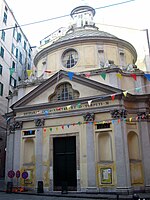Santi Cosma e Damiano, Genoa
All pages needing cleanupRoman Catholic churches in GenoaRomanesque architecture in GenoaWikipedia pages needing cleanup from February 2012

The church of Santi Cosma e Damiano is located in central Genoa, ItalyLocated at the site of an ancient oratory, it is dedicated to the martyrs St. Cosma and Damian. The skull and tibia of the latter are presumably among the relics in the church. They were the patron saints of barbers and doctors. The first documents about the church date to 1049. In 1684, the church roof was damaged by the naval bombardment of the city. It was also damaged during the bombing of Genoa in World War II. It contains a painting of Esther and Assuerus by Bernardo Castello and a Madonna and child with St Cosma and Damian by Gioacchino Assereto.
Excerpt from the Wikipedia article Santi Cosma e Damiano, Genoa (License: CC BY-SA 3.0, Authors, Images).Santi Cosma e Damiano, Genoa
Vico di San Cosimo, Genoa Centro Est
Geographical coordinates (GPS) Address Nearby Places Show on map
Geographical coordinates (GPS)
| Latitude | Longitude |
|---|---|
| N 44.406669444444 ° | E 8.9287472222222 ° |
Address
Zaccaria
Vico di San Cosimo 3 rosso
16123 Genoa, Centro Est
Liguria, Italy
Open on Google Maps











